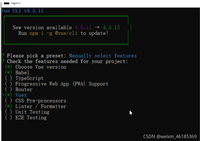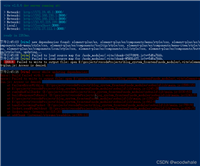1.对于从接口请求的数据
尽量使用{{}}加载,而不是v-html。
vue中的大括号会把数据解释为普通文本。通常如果要解释成html代码则要用v-html。
而此指令相当于innerhtml。
虽然像innerhtml一样不会直接输出script标签,但也可以输出img,iframe等标签。
vue文档关于v-html的说明如下所示:
2.对用v-html和innerhtml加载的客户信息进行转义
如果显示内容里面有html片段,一定需要用v-html或者innerhtml加载
例如:
<div v-html="`<span>${message}</span>`"></div>里面的message是客户自己输入的信息,如果此时是恶意的dom片段肯定会引起xss攻击。此时我们可以对“<”,">"转译成“<”,“>”。然后再输入到页面。
可以使用lodash里面的escape方法对客户信息进行转译。
如下:
import _escape from 'lodash/escape' vue.prototype.$escape = _escape
在vue中插入一个全局方法,对需要转译的数据就使用这个方法:
<div v-html="`<span>${$escape(message)}</span>`"></div>3.在入口页面的meta中使用csp
在入口文件的head添加meta标签
<meta http-equiv="content-security-policy" content="script-src 'self';style-src 'self'">
<meta http-equiv="content-security-policy" content="style-src 'self' 'unsafe-inline';script-src 'self' 'unsafe-inline' 'unsafe-eval' https://webapi.amap.com https://restapi.amap.com https://vdata.amap.com https://appx/web-view.min.js;worker-src blob:">
该指令说明:允许自身css、js和高德地图api、地图数据。
上面的csp设置表示,script脚本资源和style样式资源只能加载当前域名下的资源。这样子可以避免外部恶意的脚本的加载和执行。
如果页面有例如下面的标签,那这些cdn资源是加载不了的。
<link href="https://cdn.bootcdn.net/ajax/libs/font-awesome/1.0.0/css/font-awesome.css" rel="stylesheet"> <script src='https://cdn.bootcdn.net/ajax/libs/angular.js/0.10.0/angular-ie-compat.js'></script>
题外话:个人不倡议用第三方cdn,其一是不会减少页面加载资源的体积,其二是第三方cdn稳定性不能保证,有时候第三方cdn的服务器会挂掉导致需要的资源加载不了。
一般会用下面的csp配置:
<meta http-equiv="content-security-policy" content="script-src 'self' 'unsafe-eval';style-src 'self' 'unsafe-inline'">
设置解释:
- script-src:只加载当面域名服务器下的资源,且允许eval执行脚本。因为webpack在development模式下大量使用eval进行脚本注入,且在development中常用的souce-map是cheap-module-eval-source-map。
- 如果script-src设置成‘self’会阻止eval的使用。
- style-src:只加载当面域名服务器下的资源,且允许使用内联资源。有时候无论在开发环境还是生产环境,可能都是通过webpack打包把css内容打包到js文件里面。加载页面时,js脚本会在页面中插入一个个style标签补充层叠样式模型。如果style-src设置成‘self’会阻止style内联样式的插入和执行。
4.针对特殊场景,选择性过滤xss标签
在项目中,xss的安全漏洞很容易出现,例如在聊天模块和富文本模块很容易出现。
有时候你想实现富文本编辑器里编辑html内容的业务。
可是又担心xss恶意脚本的注入。
此时可以使用一个xss工具。
网址:https://github.com/leizongmin/js-xss。
更详细的用法可以看附上的网址,这里简单说一下用法。
首先下载xss
npm i xss -s
(1)在页面中引入资源且生成xss过滤器,对内容进行过滤
var xss = require("xss")
const option={} //自定义设置
const myxss = new xss.filterxss(option);
const line='<script type="text/javascript">alert(1);</script>'
var html = myxss.process(line);
console.log(html); //输出:<script type="text/javascript">alert(1);</script>(2)如果我想不过滤img标签的onerror属性,或者不过滤style标签。
通过设置whitelist可选择性的保留特定标签及其属性
例如:
const option={
whitelist:{
img:['src','onerror'] //img标签保留src,onerror属性
style:['type'] //style标签默认是不在whilelist属性里的,现在添加上去
}
}
const myxss = new xss.filterxss(option);
letline='<img src="./123.png" onerror="alert(1);" alt="123">'
let html = myxss.process(line);
console.log(html); //输出:<img src="./123.png" onerror="alert(1);">
line='<style type="text/css">color:white;</style>'
html = myxss.process(line);
console.log(html); //输出:<style type="text/css">color:white;</style>xss默认的whitelist可以通过console.log(xss.whitelist)显示。
(3)如果想彻底过滤掉类似script,noscript标签,option可如下设置:
const option={
stripignoretagbody: ["script","noscript"],
}
const myxss = new xss.filterxss(option)
let line='<script type="text/javascript">alert(1);</script>'
let html = myxss.process(line)
console.log(html.length) //输出0,即html被转化为空字符串
line='<noscript>123</noscript>'
html = myxss.process(line)
console.log(html.length) //输出0,即html被转化为空字符串stripignoretagbody用于设置不在whitelist的标签的过滤方法。
例如script,不在whitelist会被执行xss内部的escapehtml方法。如一开头的例子会把“<”,“>”进行转义。
但如果stripignoretagbody中添加了script。则会直接把整个script标签过滤掉。
(4)xss默认生成的过滤器是会过滤掉任何标签的class属性。
如果我们不想过滤任何在whitelist的标签的class属性,可以这么设置:
const option={
onignoretagattr: function(tag, name, value, iswhiteattr) {
if (['style','class'].includes(name)) {
return `${name}="${xss.escapeattrvalue(value)}"`
}
},
}
const myxss = new xss.filterxss(option);
let line='<div class="box"></div>'
let html = myxss.process(line);
console.log(html); //输出:<div class="box"></div>onignoreattr方法用于设置白名单中特定属性的过滤方法。
更多详细教程请看一开头附上的网址。
总结
以上为个人经验,希望能给大家一个参考,也希望大家多多支持代码网。






发表评论